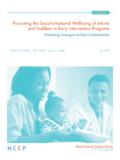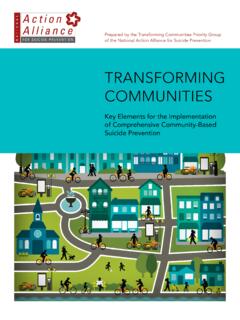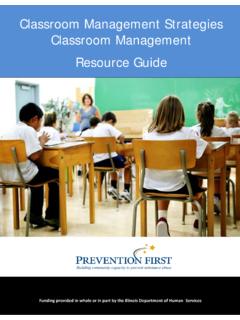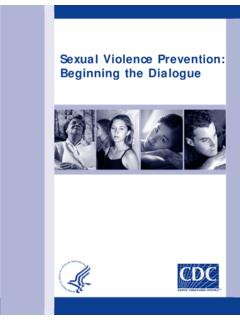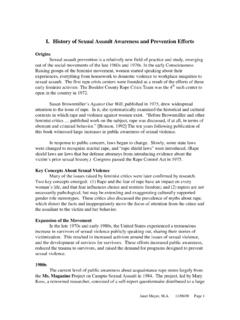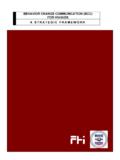Transcription of Community-Based Physical Activity Programs For Older ...
1 Moving ahead strategies AND TOOLS TO PLAN, CONDUCT, AND MAINTAIN effective Community-Based Physical Activity Programs FOR Older ADULTS: A BRIEF GUIDE A PUBLICATION OF THE PREVENTION RESEARCH CENTERS HEALTHY AGING RESEARCH NETWORK ABOUT THE PREVENTION RESEARCH CENTERS-HEALTHY AGING RESEARCH NETWORK CDC s Prevention Research Centers-Healthy Aging Research Network (PRC-HAN) has developed a research agenda on the determinants of healthy aging and on interventions that promote healthy aging. The nine university members of the PRC-HAN, a subset of 33 Prevention Research Centers located throughout the United States, provide the PRC-HAN with the expertise necessary to address topic areas within the research agenda.
2 As with all PRC research Programs , there is a strong focus on partnering with Community-Based groups to develop Programs that improve health, with a special emphasis on those communities and populations that bear a disproportionate burden of illness and disease. PRC-HAN member universities include: Texas A&M University University of California, Berkeley University of Colorado at Denver and Health Sciences Center University of Illinois at Chicago University of North Carolina at Chapel Hill University of Pittsburgh University of South Carolina University of Washington: PRC-HAN Lead Coordinating Center West Virginia University CITATION Use this citation when referencing this work: Belza B.
3 And the PRC-HAN Physical Activity Conference Planning Workgroup (2007). Moving Ahead: strategies and Tools to Plan, Conduct, and Maintain effective Community-Based Physical Activity Programs for Older Adults. Centers for Disease Control and Prevention: Atlanta, Georgia. TIME TO GET MOVING, KEEP MOVING Encouraging Older adults to become and stay active has developed into an important public health priority. While the Physical and emotional benefits of exercise are increasingly well known, just 40 percent of Older adults are engaged in regular leisure-time Physical Activity . In recent years, researchers and research institutions have begun to develop and test a variety of new evidence- based Programs in Physical Activity , several of which have produced significant measurable health benefits and other positive outcomes for Older participants.
4 In turn, with support from the federal government and private funders, public health systems and providers of aging services have sought to adapt these research models for application in the real world in the hope that similar outcomes will be achieved by Older adults in senior centers, housing sites, Y s, and other community settings. The Healthy Aging Research Network of CDC s Prevention Research Centers program (PRC-HAN) has actively participated in this evolution. Its members have served as evaluators, consultants, and in some cases program developers for these Physical Activity interventions. PRC-HAN members understand that helping Older adults benefit from powerful new Programs (several of which are highlighted in this document) will require taking what we know from research and making that knowledge usable and available to the broader community of providers in public health and aging services.
5 To that end, the PRC-HAN held a symposium in Seattle, Washington, in February 2007. This meeting gathered more 160 professionals both researchers and service providers to highlight some of the best evidence- based Programs in Physical Activity now available and provide a forum to explore challenges and successful strategies associated with creating flourishing Programs in communities across the country. The PRC-HAN organized the meeting around the RE-AIM framework, a comprehensive approach to interventions in health behavior that was developed by Russ Glasgow, PhD, and colleagues; it includes planning, dissemination, and evaluation (for a fuller description, please see page 2).
6 The resulting two days of high quality presentations, spirited question-and-answer sessions, and highly interactive small-group discussions deepened researchers awareness of the practical concerns involved in starting and running evidence- based Programs . Just as importantly, the symposium provided service providers with new tools and insights that presenters at the symposium hope are being used in places from Portland, Maine, to Honolulu, Hawaii. While a brief publication cannot capture the full flavor and excitement of these two days, we offer this monograph to make some of the conference s key learnings more broadly accessible. We hope it will increase your knowledge of evidence- based Physical Activity Programs and the value of the RE-AIM framework for planning and delivering these Programs .
7 We also hope that it will suggest new strategies , practical ideas, and helpful tools that you can use wherever you work on behalf of Older adults. The discussion begins with an overview of RE-AIM and its essential components, followed by sections devoted to each of those components. The sections include explanations and suggestions for using the component under discussion, a practical example from a real-world implementation, and a list of online and print tools that can help you in your own implementation of each component. The final section offers more general tools to help you through each step of the RE-AIM process. While heartened by the positive response and the energy generated by the symposium, we also understand that this is just the beginning of what is needed.
8 It is time for all of us to get moving and keep moving to ensure that these exciting evidence- based Programs in Physical Activity become more broadly available for the growing number of Older adults who need them in communities everywhere. 1 re-aimA COMPREHENSIVE FRAMEWORK FOR PROGRAM PLANNING AND EVALUATION effective , practical, evidence- based interventions for health promotion and self-management of chronic disease offer advantages for both Older adults and program planners. As program participants, Older adults can look forward to improvements in their health. Program planners can proceed confidently with the knowledge that these Programs will yield demonstrable, measurable outcomes that both healthcare partners and funders seek and increasingly support.
9 Successful implementation, however, requires careful attention and effort from recruiting participants to ensuring that the program is run in a high quality, consistent manner. To help program planners, evaluators, funders, and policymakers plan, evaluate, and implement health Programs in real world settings, psychologist Russell E. Glasgow, PhD, and his colleagues developed a conceptual framework called RE-AIM. Initially created to evaluate interventions in health behavior, RE-AIM also serves as a helpful planning tool for a whole range of Programs and policies in health promotion. 2 The acronym RE-AIM stands for Reach, Effectiveness, Adoption, Implementation, and Maintenance, which are the five critical elements in the program development process: REACH describes the absolute number, proportion, and representativeness of the persons who participate in a given program.
10 Representativeness refers to the extent to which participants characteristics are the same as or different from those who are eligible but do not participate. For example, if you intended to increase Physical Activity among sedentary but relatively healthy people between the ages of 65 and 85, you would compare information on demographics, health, and Physical Activity of those who participated with those who met your recruitment criteria but declined to join. If there are no significant differences between the two groups, your participants are likely representative of the entire population you hoped to reach. If that is the case, you can then more confidently advocate expanding the program further.











